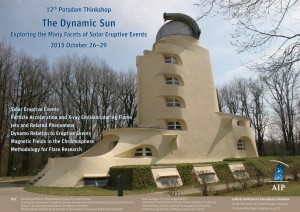The Relation between CME Topologies and Observed Flare Features
Antonia Savcheva (Harvard-Smithsonian Center for Astrophysics)
Abstract. A long established goal of solar physics is to build physics-based flare and CME forecasting models. This study, building on the recent successes in non-linear forces free field (NLFFF) modeling and detailed numerical simulations, brings us closer to that goal. We show that data-constrained NLFFF models built to reproduce the active region magnetic field in the pre-flare state can be rendered unstable and the sequence of unstable solutions produce quasi-separatrix layers (QSLs) that reproduce the observed flare ribbons. The results are fully consistant with the 3D extension of the standard flare/CME model. Our ability to capture essential topological features of flaring active regions with non-dynamic magneto-frictional code strongly suggests that the pre-flare, large scale topological structures are preserved as the flux rope becomes unstable and lifts off. Three active regions are studied using Solar Dynamics Observatory (SDO) observations from the Atmospheric Imaging Assembly (AIA) and the Heliospheric Magnetic Imager (HMI) to constrain NLFFF models. Stable models that are well matched to pre-flare coronal loops are rendered unstable by the addition of axial magnetic flux. This results in a series of solutions in the magneto-frictional relaxation with the flux rope evolving to different heights. We analyze the evolution of the magnetic filed line connectivity and QSLs as the flux ropes rise. We present maps of the QSLs and current in cross sections through the flux ropes, which present the dynamical nature of the solutions. We compare the chromospheric maps of the squashing factor, Q, with flare ribbon positions at different times during the flare. The correspondence of the sequences of QSLs and the ribbon evolution in the three cases is compelling evidence that the magnetic models are capturing the large scale structure of the flaring active region.
Contributed Talk

Write a comment Close comment form